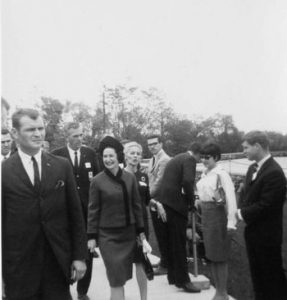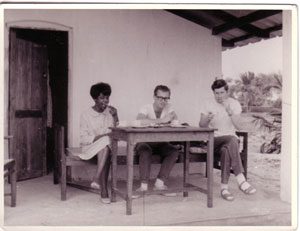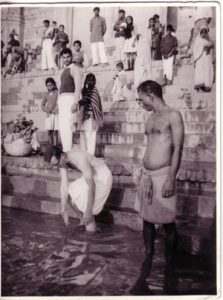Accession Date: October 6, 2021
Access: No restrictions
Collection Size: 1 archived website
Document Types

Accession Date: October 6, 2021
Access: No restrictions
Collection Size: 1 archived website
Document Types
Access: No restrictions
Collection Size: 1 archived website
Document Types
Country of Service: Ecuador
Dates in Service: 1966-1968
Accession Date: July 6, 2021
Access: No restrictions
Collection Size: 1 archived blog
Document Types
Peace Corps Volunteers are trained and sent abroad in groups. They often visit each other while in country and remain in contact for decades after their service. One such group is India 20A, which has hosted many reunions in the past fifty years and have a website that details their service.
India 20A trained in public health at the University of Wisconsin-Milwaukee. After three months, August to November, the original group of 65 was reduced to 37 and sent to India. They spent 1965-1967 serving the country.

Mrs. Lady Bird Johnson walks past India 20A trainees standing in a presentation line. Visible are trainees Steve Sloane, Julie Revilla, and Phil Scholl.

PCTs Normal Bell, David Johnson, Werner Hollstein, and Richard Smith starting work on an outhouse constructed as part of our two-week experience on the Stockbridge-Munsee Indian Reservation in Wisconsin. October 1965.
At the time, India was experiencing extensive health issues. The people were at the mercy of tuberculosis, malaria, cholera, smallpox, and plague, so the government asked for Peace Corps assistance.

Cheyl Axtell, Gerry Hysashida, Penny Pendleton, and Marilyn Martiny at their site in Trichur, Kerala.

Essie Jackson, Richard Smith, Dave Johnson at home in Puthenthope, Kerala. Newly arrived in December 1965.
Once in India, volunteers worked with the Public Health Center “to extend its preventative and promotional health work into the villages.” They had 3 goals:
Their “priority was on provision of safe water supply, healthy housing, and sanitary disposal of human excreta.”

Richard Smith bathing in the Ganges River at dawn 1967.
While in India, volunteers not only helped promote better health, they also experienced Indian culture in many different ways.
Throughout the years, the group has kept in contact through reunions and return trips to India.
To find out more information about the group India 20A, check out their website here: www.india20a.org which details their training process, how they corresponded with family and friends, their experiences in India, and many more photos of their service.
A video of volunteer Phil Scholl’s experience can be found here: Peace Corps Group “India 20A” in India 1965-1967, it details his travels through India, various village markets, the domestic life of villagers, and a large festival.
—-
Other volunteer groups have created group websites as well, such as the Friends of Brazil. Their website chronicles the history of volunteer groups that served in Brazil. It shows the different states people served in, where people trained, who served, and where they served. The website is a comprehensive look at the Brazil Peace Corps program during its existence from 1962-1980.
Find the website here: Peace Corps Brazil
*All pictures and information are courtesy of the India 20A website.
Alongside the annual conference of the National Peace Corps Association held in Washington, D.C. in September 2016, AU Archives and Special Collections is debuting two exhibits highlighting its Peace Corps Community Archive. One exhibit will be a physical exhibit on campus and the other online.
The Peace Corps through the Lens of its Volunteers will be on display through the end of the semester on the third floor of the Bender Library.
The Peace Corps and Its Volunteers, the online companion exhibit, will go live this Friday August 26.
Both exhibits draw from the Peace Corps Community Archive and showcase the experiences of Peace Corp Volunteers through journals, letters, and photographs from the 1960s to the present.
For more information, please visit the Peace Corps Community Archive website. To use the collections or make a donation, please contact the AU Archives at archives [at] american.edu.
Peace Corps Brazil website
Country of Service: Brazil
Dates in Service: 2000 – 2015
Accession Date: June 14, 2015
Access: No restrictions
Document Types
http://wayback.archive-it.org/1435/20150604165058/http://www.expcvsbrazil.com/
Brienne Thomson
Country of Service: Paraguay
Place of Service: San Estanislao
Service Type: Community Economic Development
Dates in Service: 2013-2015
Keywords:Paraguay, San Estanislao, Community Development, Economic Development
Accession Date: November 17, 2014
Access: No restrictions
Collection Size: 9 items
Document Types and Finding Aid
From a quick look at our Peace Corps catalog, it becomes apparent that many of our collections are of those who served during the 1960s. To what extent however, are the other decades in which people served represented? The graph below presents our collections in a visual format, indicating trends in Peace Corps activity expressed through our holdings. (Note: Each year corresponds to each Peace Corps volunteer’s year of entry into the two-year program)
Cole Shaw
Country of Service: Mexico
Place of Service: Nuevo Leon
Service Type: Engineering (CONACYT)
Dates in Service: 2009-2011
Keywords: Community Development, Information Technology, Health
Accession Date: July 10, 2014
Access: No restrictions
Collection Size: 1 item
Document Types and Finding Aid
https://wayback.archive-it.org/1435/20140825194452/http://awolverineinmexico.blogspot.com/
The Peace Corps Digital Library collects and displays images and stories from Peace Corps staff and volunteers. It’s a great place to begin if you are interested in learning about or conducting research on the organization’s history and work around the world.
From the main page, it is easy to browse the collection for photos and stories from the agency, staff and volunteers. Also included in the digital collection, are technical and training materials, brochures, graphics, and volunteer and agency documents. Peace Corps Digital Library offers similar materials to those in the Peace Corps Community Archive, but also differs in several ways.
Differences between PCCA and the Peace Corps Digital Library
PCCA accepts only materials from returned volunteers. At this time, PCCA does not collect materials from former Peace Corps staff. The collection includes original materials—diaries, notebooks, training materials, slides, video, images, and sound recordings—created during volunteers’ training and service abroad. Although it isn’t possible to search at the item level, it is possible to search collections using the online catalog. The search feature allows researchers to identify collections containing specific types of items using key terms and categories.
The Peace Corps Digital Library only accepts materials in digital format and is completely online. Having the content online enables users to search key terms, dates, types of materials, creator, and subject, which makes it easier to locate specific images or documents. PCCA’s collection level approach facilitates establishing context and drawing conclusions about the Peace Corps experience.
Peace Corps Digital Library also differs from the PCCA because it includes a “story” component where volunteers and staff contribute stories about their Peace Corps experiences. Volunteers and staff may write and submit one story in 1,500 words or less to be published in the digital library. The PCCA collects volunteers’ stories, conveyed through archival documents, as well as unpublished memoirs but not individual stories.
For more information on contributing, or to browse items in the Peace Corps Digital Library visit their site. If you have more than a single story or image to share with the public, consider donating to the Peace Corps Community Archive.